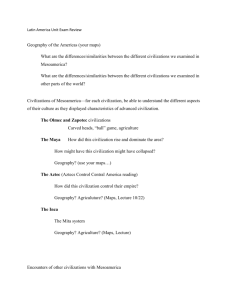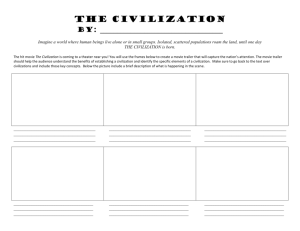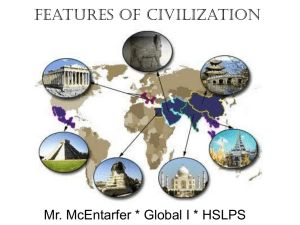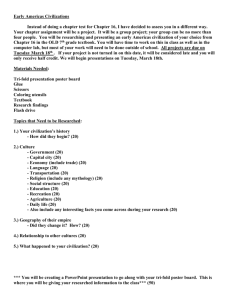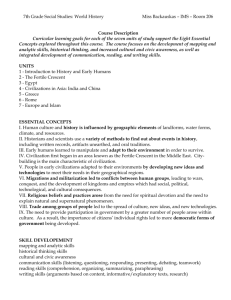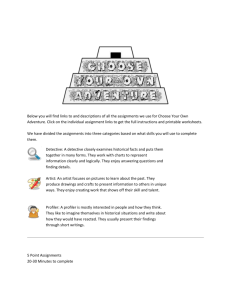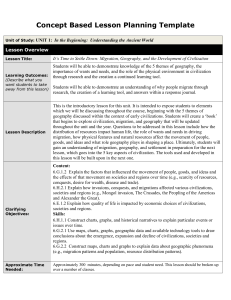Lesson Plan Excerpt Day 3 Open: Review the brainstormed
advertisement
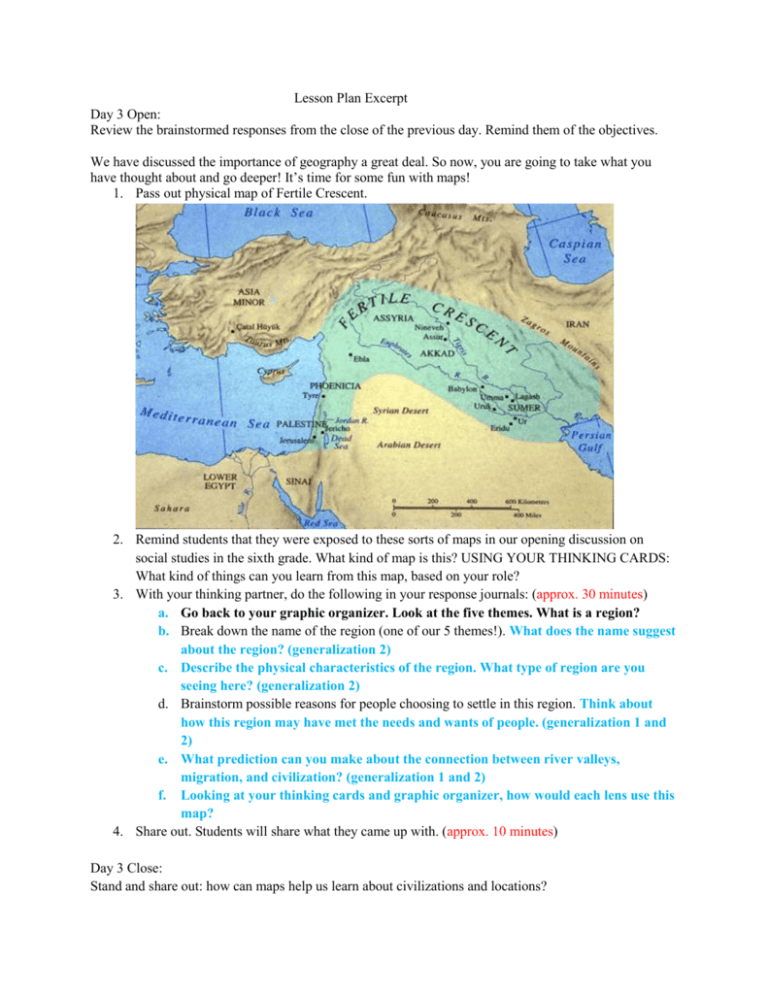
Lesson Plan Excerpt Day 3 Open: Review the brainstormed responses from the close of the previous day. Remind them of the objectives. We have discussed the importance of geography a great deal. So now, you are going to take what you have thought about and go deeper! It’s time for some fun with maps! 1. Pass out physical map of Fertile Crescent. 2. Remind students that they were exposed to these sorts of maps in our opening discussion on social studies in the sixth grade. What kind of map is this? USING YOUR THINKING CARDS: What kind of things can you learn from this map, based on your role? 3. With your thinking partner, do the following in your response journals: (approx. 30 minutes) a. Go back to your graphic organizer. Look at the five themes. What is a region? b. Break down the name of the region (one of our 5 themes!). What does the name suggest about the region? (generalization 2) c. Describe the physical characteristics of the region. What type of region are you seeing here? (generalization 2) d. Brainstorm possible reasons for people choosing to settle in this region. Think about how this region may have met the needs and wants of people. (generalization 1 and 2) e. What prediction can you make about the connection between river valleys, migration, and civilization? (generalization 1 and 2) f. Looking at your thinking cards and graphic organizer, how would each lens use this map? 4. Share out. Students will share what they came up with. (approx. 10 minutes) Day 3 Close: Stand and share out: how can maps help us learn about civilizations and locations? Day 4 Open: Warm up Performance Task: Following the discussion of reasons for migration and the role of geography, students will transition into the library for the following piece of the lesson. (approx. 120 minutes; suggest one class period of library exploration and then outside of class) 1. Exploration: On the map that you have been provided are a number of locations and associated civilizations: a. Egypt b. Phoenicia c. Assyria d. Akkad e. Assyria f. Catal Huyuk With your thinking partner, do the following: a. Select a location. b. ‘Explore’ the location using the tool of your choice. You may use books from the library, encyclopedias, or the internet. Note for teachers: You may use this as an opportunity to integrate the information and technology standard expectations! This is an opportunity for you to see where your students are in relation to effective internet research. It may be a good idea to collaborate with the media specialist (if available) to provide an overview of internet research. Possible tool: view the linked powerpoint and complete the linked worksheet to ensure that you are aware of the strengths and weaknesses of internet research. This must be done and turned in to the teacher BEFORE beginning your research. Powerpoint: http://readwritethink.org/lesson_images/lesson983/presentation.ppt Worksheet: http://readwritethink.org/lesson_images/lesson983/student.pdf In your exploration, address the following questions: 1. What is the name of the civilization or location that you are researching? 2. When was your civilization or location settled? 3. What physical characteristics of the location drew settlers? How did it help people meet their wants and needs? 4. What were the strengths and weaknesses of the location? (for example, it had access to water, but also suffered from flooding) How did human beings interact with these strengths and weaknesses? 5. Did it have any interactions with other locations, people, or civilizations? How and why? 6. Connect your location/civilization to each of the 5 themes of geography as described within your graphic organizer (this may be done as a part of other questions or separately). a. Location: How does the importance of your location change over time? Where exactly on the earth is your location? What is your civilization’s location in relation to others? b. Place: How would you describe your location physically, and what are the natural resources? What type of human characteristics are evident (land use, housing, industry, etc)? c. Human-Environment Interaction: how do people in your civilization/location depend on, modify, or adapt to the environment? d. Movement: what examples of movement of people, goods, or ideas do you see? What connections to other locations/civilizations do you see? e. Regions: what region is your location/civilization in. Remember that regions can be based on physical characteristics OR human characteristics. 7. Create a timeline of the location or civilization that shows important events in its history and geography. 8. Create a map of your location that illustrates the physical and human characteristics of the location. What makes the location a good place for settlement? 9. Develop at least one to two questions relating to each of the lenses. What kind of questions might a historian ask? Geographer? Political scientist? Cultural anthropologist? Economist? *10. Create a list of questions for further exploration later in the unit. These questions should center around things that you discovered in your research that you would like to learn more about and relate to history, geography, culture, technology, institutions, or other features of civilization. (THIS IS AN OPTIONAL PIECE, BUT MAY SERVE AS A GUIDE FOR FURTHER RESEARCH AS STUDENTS MOVE DEEPER INTO THE UNIT). Students will complete chart that addresses each of the questions, and include their map and timeline. These charts will be compiled into a ‘quick reference’ book for each student to use and build on throughout the unit. In the next lesson within the unit, students will learn about the 5 key aspects and then use their selected civilization/location as a ‘case study’ illustrating how each one demonstrates the 5 key aspects. These will be added to the student ‘books’. 11. Teacher should compile charts and return to students. Provide class feedback on what was observed within compiled graphic organizers. Address issues of concern and lingering questions. Students review the compiled books and move into small groups. Each student will teach their ‘page’ of the book with the group, and readers have the opportunity ask the creators questions about what was found. (approx. 50 minutes)
